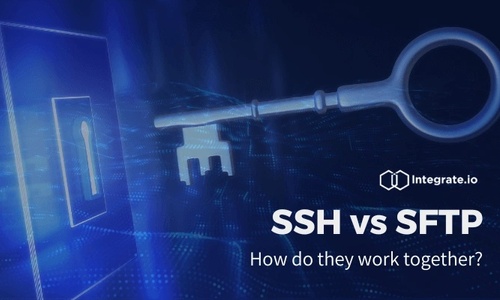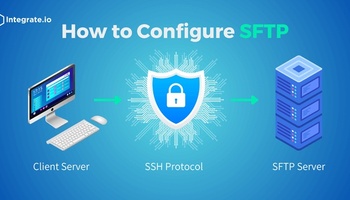In the digital age, data transfer is as essential as air. SSH and SFTP are two pivotal protocols that have made secure data transfer possible. This article explores these two protocols, offering a deep dive into their functionality, history, and differences.
5 Key Takeaways from the Article:
- SSH (Secure Shell) is a network protocol enabling secure connections between two systems.
- SFTP (SSH File Transfer Protocol) allows secure file transfer, leveraging SSH for encrypted connections.
- While SSH is designed for secure command execution, SFTP focuses on secure file transfers.
- Both SSH and SFTP have unique strengths that suit different use cases.
- Choosing between SSH and SFTP is often a matter of understanding your specific needs and security requirements.
In this article, we will journey through the world of SSH and SFTP, dissecting their key differences, uses, and security aspects.
Understanding SSH (Secure Shell)
SSH, short for Secure Shell, is an integral part of the cybersecurity toolbox. Initially created as a more secure alternative to non-protected login protocols like Telnet, SSH was born out of a need for secure and reliable network operations in a volatile internet environment. This protocol provides a robust framework for remote server management and file transfer, lending its security foundation to numerous other applications.
What is SSH? Brief Explanation and History
SSH, an open-source network protocol, was developed by Tatu Ylönen in 1995 in response to a password-sniffing attack at his university network. SSH1 was the initial release, designed to provide secure remote logins to Unix servers. However, it suffered from some security flaws, leading to the development of SSH2 - an enhanced and more secure version. Unlike its predecessors, SSH2 features robust mechanisms for encryption, authentication, and data integrity, making it the preferred choice for secure remote connections.
Core Features of SSH
The Secure Shell's core functionalities are built upon principles of security, data integrity, and interoperability:
- Authentication: SSH uses public key authentication to verify the identity of the remote server or client, preventing unauthorized access. It can also work with passwords, though key-based authentication offers superior security.
- Encryption: The data transmitted over SSH connections is encrypted using strong algorithms, ensuring confidentiality. This protects the data from being readable if intercepted during transit.
- Data Integrity: SSH uses cryptographic hashes to maintain data integrity, assuring the receiver that the data has not been tampered with during transmission.
- Tunneling and Port Forwarding: SSH can tunnel network traffic over encrypted connections, encapsulating other network protocols like FTP or Telnet. This enhances the security of these otherwise insecure protocols.
- Compatibility: SSH is platform-agnostic and can be used with any operating system that supports it, including Linux, Microsoft, and various UNIX versions.
How SSH Works: Technical Breakdown
SSH operates on a client-server model. When a connection is requested, the server responds with its public key. The client verifies the server's identity, and if it's a known host, the client encrypts a random number with the server's public key and sends it back. Only the server, with its private key, can decrypt this number. This establishes a secure connection between the client and the server.
Security Aspects of SSH
SSH was designed with security at its core. From its robust public key authentication to its secure connection establishment, every aspect of SSH prioritizes data protection. It utilizes strong encryption algorithms like AES, 3DES, and Blowfish to ensure data confidentiality. Additionally, SSH uses Message Authentication Codes (MACs) to verify data integrity and authenticity.
Common Uses of SSH and When It's Most Appropriate
SSH is an essential tool for network administrators, webmasters, and anyone requiring secure, remote access to a server. It's commonly used for:
- Secure System Administration: By providing encrypted connections, SSH allows administrators to remotely log in to systems and perform tasks securely.
- Secure File Transfers: Using protocols like SCP and SFTP, SSH can transfer files between machines securely.
- Port Forwarding/Tunneling: SSH can create secure tunnels for other network services which can then operate securely over an insecure network.
- Command Execution: SSH can execute commands on a remote server, providing a secure shell for the user.
In essence, SSH should be used whenever there's a need for secure, remote system access or when data integrity and privacy are paramount. Its functionality goes beyond just remote logins, providing a secure framework for various network services.
Understanding SFTP (SSH File Transfer Protocol)
Following the path paved by SSH, Secure File Transfer Protocol, or SFTP, emerged as a reliable and secure method for data transfer. SFTP, a network protocol, embodies the same principles of security and integrity as SSH while focusing primarily on secure file handling and manipulation.
What is SFTP? Brief Explanation and History
SFTP, sometimes known as SSH File Transfer Protocol, was designed as a secure alternative to the File Transfer Protocol (FTP). FTP, despite being highly functional, lacked robust security measures, leaving data vulnerable during transfer. Recognizing this shortfall, the creators of SSH developed SFTP as a protocol that could use SSH's secure shell for file transfers, thereby achieving both functionality and security.
SFTP isn't just FTP over SSH; it's a distinct protocol designed from scratch. It first appeared in SSH2 and has since become a standard method for secure file transfer, particularly on Unix and Linux systems.
Related Reading: SFTP vs. FTP: Understanding the Differences
Core Features of SFTP
SFTP has several key features that set it apart:
- Secure Data Transfer: SFTP uses the underlying SSH protocol to provide secure, encrypted data transfer.
- File Management: Beyond file transfers, SFTP allows for other file operations on both local and remote systems, such as renaming, deleting, and changing the attributes of files.
- Directory Browsing: SFTP allows users to browse directories on both the client and server side, improving file management capabilities.
- Compatibility: SFTP is platform-agnostic and can be utilized across a range of operating systems, including but not limited to Linux, UNIX, and Microsoft systems.
- Public Key Authentication: Like SSH, SFTP uses public key authentication, which offers higher security levels than password-based authentication.
- Public Key Authentication: SFTP, similar to SSH, uses public key authentication, which offers higher security levels than password-based authentication. While both can work with passwords, key-based authentication provides superior security.
Related Reading: How Secure is SFTP?
How SFTP Works: Technical Breakdown
SFTP operates as a subsystem of SSH, utilizing the same secure connection.
Here's how it works:
- An SSH connection is established between the client and server using the server's public key.
- Once the secure connection is made, SFTP initiates a series of requests and responses between the client and the server. These requests can range from uploading a file to changing its permissions.
- The server processes the request and responds appropriately. If the client requested a file upload, for example, the server would respond with a confirmation of successful transfer once the upload was complete.
- The SFTP client continues to send requests over the established SSH connection until the session ends.
Security Aspects of SFTP
SFTP's security is largely dependent on its SSH backbone. The same encryption and authentication mechanisms apply, ensuring that file transfers and file management commands are carried out securely. SFTP also supports the transport layer security, protecting data during transmission.
Common Uses of SFTP and When It's Most Appropriate
SFTP is commonly used for secure file transfers across different operating systems. Its use cases include:
- Secure File Transfers: This is the most common use of SFTP. It's particularly beneficial for transferring sensitive or critical files.
- Secure File Management: Because of its robust file-handling capabilities, SFTP is often used for file management on remote servers.
- Data Backups and Synchronization: SFTP is often used to securely back up and synchronize data between different servers or systems.
SFTP is best used when security is critical for file transfers, and when file operations need to be performed on remote servers. Given its built-in compatibility and robust file management capabilities, SFTP is a versatile and secure solution for remote file handling.
SSH vs SFTP: Key Differences
Navigating the realm of secure network protocols like SSH (Secure Shell) and SFTP (SSH File Transfer Protocol) can be intricate. Both have their roots in SSH, yet they serve distinctive purposes. SSH is designed primarily for secure remote command execution, while SFTP provides secure file transfer capabilities.
In terms of security, both SFTP and SSH have equal firewall compatibility and security due to their shared protocol foundation. While SFTP is especially recognized for its secure file transfer and management capabilities, SSH distinguishes itself through its wide adoption and versatility in remote command execution.
Performance comparisons reveal minor differences that typically hinge on network conditions and specific use cases. To further illuminate the distinctions between SSH and SFTP, let's delve into a side-by-side comparison in the following table:
|
SSH |
SFTP |
|
|
Purpose |
Primarily used for executing commands on remote servers and managing secure logins. |
Primarily used for secure file transfer and file management on remote systems. |
|
Protocol Type |
A network protocol for creating a secure connection. |
A network protocol that uses SSH for secure file transfers. |
|
Security |
SSH is a secure protocol that uses encryption to protect data in transit. |
SFTP also provides secure data transfers, utilizing SSH for encryption. |
|
Authentication |
Uses public-key authentication, password-based authentication, or both. |
Uses the same authentication methods as SSH, typically public-key authentication. |
|
Compatibility |
Compatible with a wide range of operating systems and devices. |
Similar compatibility to SSH but specifically used for file transfers and file management across different systems. |
|
Functionality |
Used for remote command execution, port forwarding, and secure data communication. |
Primarily used for file and directory operations, including secure file transfer, deletion, renaming, and browsing. |
|
Performance |
SSH's performance is generally high, but it depends on the network conditions. |
SFTP might have slightly lower performance due to the additional overhead of file operations but remains quite efficient. |
|
Common Use Cases |
Remote system management, secure tunneling, and secure file transfers with SCP. |
Secure file transfers, remote file management, and data backup or synchronization. |
In terms of security, both SSH and SFTP offer robust protection due to their reliance on encryption and secure authentication methods. For performance, while SFTP may experience slight overhead due to file operations, both are highly efficient given good network conditions. The deciding factor between SSH and SFTP often comes down to their specific use cases and functionality.
Scenario Analysis: When to Use SSH or SFTP?
SSH is the protocol of choice for secure remote command execution. If you're dealing with server administration, especially in a Linux environment, SSH is your go-to protocol.
On the other hand, if you're handling file transfers - particularly sensitive data - SFTP is a more suitable choice. It provides robust file management capabilities and is well-supported by many open-source and commercial file management tools.
Conclusion
SSH (Secure Shell) and SFTP (SSH File Transfer Protocol) both offer remarkable functionality and security in their respective domains. Despite their shared roots, they cater to distinctive needs, with SSH focusing on secure remote command execution and SFTP providing secure file transfer capabilities. Each protocol comes with its own unique strengths, making them invaluable tools for network security and data transfer.
While SFTP leads in firewall compatibility with its single connection architecture, SSH's wide adoption and flexibility make it an excellent choice for a multitude of tasks. The performance of each is largely influenced by specific network conditions and use cases, reinforcing the importance of understanding these protocols in depth before choosing one for your unique needs.
As we conclude, it's crucial to remember that the choice between SSH and SFTP should be driven by your specific needs and the level of security required. Evaluate the functionality, security, and performance metrics of both protocols to determine the best fit for your data integration and security needs.
Integrate.io comes into play as a versatile data integration platform, which can help you automate data transfer between SSH and SFTP servers. With support for a wide range of data sources and destinations, Integrate.io provides numerous features to ensure the security of your data transfers. It is designed to save you time and effort, giving you peace of mind about the security of your data transfers.
With the increasing complexity and volume of data in today's digital landscape, having a dependable platform like Integrate.io can be a game-changer. We encourage you to explore the possibilities of using Integrate.io with a 14-day trial of the platform. Alternatively, schedule a demo with one of our experts so we can better understand your data-driven projects. By understanding and leveraging these protocols, you can optimize your data management practices and further secure your digital assets.
Frequently Asked Questions (FAQs)
What are the security implications of using SSH vs. SFTP?
Both SSH and SFTP provide secure data transfer. However, SFTP has additional file management capabilities.
Can SSH and SFTP be used together?
Yes, in fact, SFTP runs over an SSH connection to provide secure file transfer capabilities.
Is SFTP faster than SSH?
The performance difference is generally negligible and depends on network conditions and specific use cases.
Is SFTP more secure than SSH?
SFTP and SSH have comparable security levels. SFTP might have an edge due to its firewall compatibility.
What are some popular SSH and SFTP clients?
Popular SSH clients include OpenSSH and PuTTY. For SFTP, clients like FileZilla and WinSCP are common choices.










